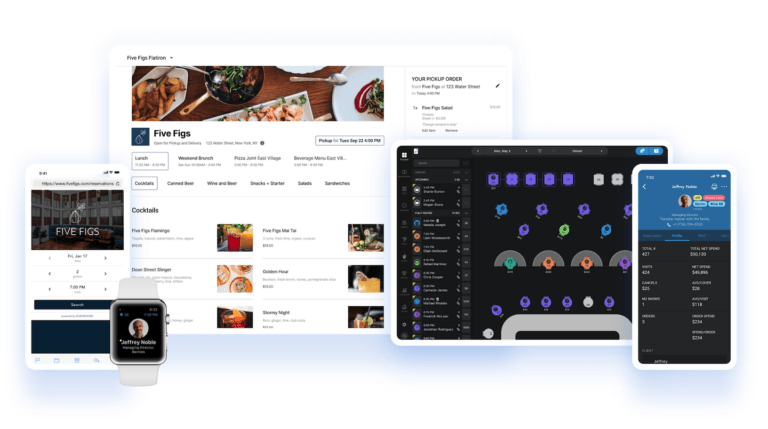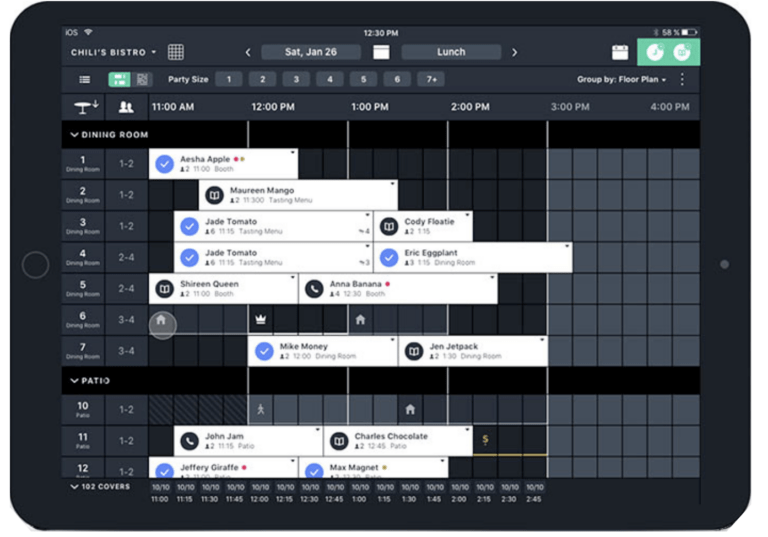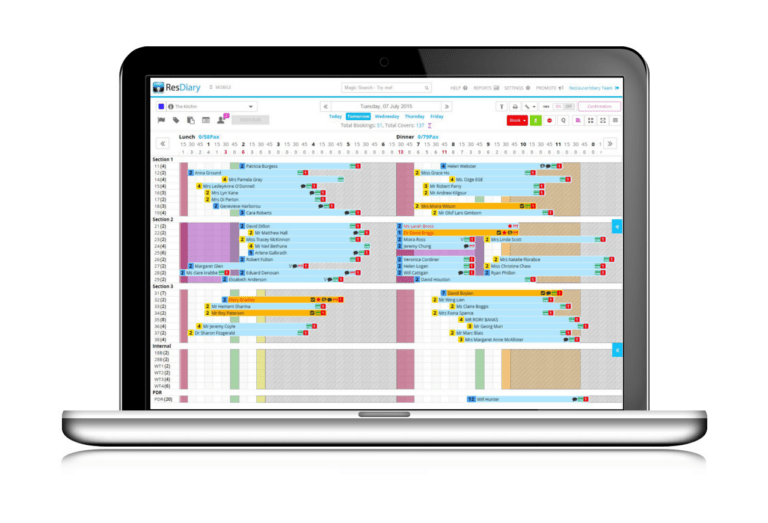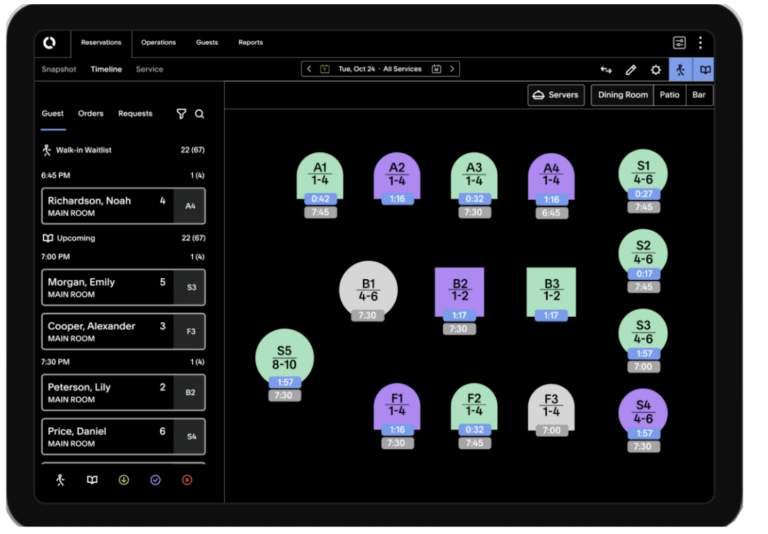Restaurant Reservation System Comparison Guide
Sevenrooms
5 min read
Aug 16, 2023

Sevenrooms
5 min read
Aug 16, 2023

Restaurants used to be able to get away with taking reservations using pen and paper — but those days are long gone. Today, restaurant reservation systems have the power to do a lot more than just fill seats. The right system can drive business, boost profits and turn one-time guests into loyal regulars.
The choices available have come just as far as the technology, and nearly every hospitality tech provider now offers an online reservation system. To make finding the right fit easier, we’ve put together a comprehensive comparison guide to the best reservation systems of 2023.

SevenRooms is an all-in-one, reservation solution and guest CRM that puts you in control of the guest experience. We offer a full suite of integrated solutions like table management, virtual waitlist and marketing software. SevenRooms was built with a focus on helping operators elevate the guest experience, improve loyalty and drive incremental revenue.
SevenRooms’ reservation system allows you to build data-rich guest profiles based on visit history and dining preferences. This data is centralized in one location and across venues giving teams, whether they’re FOH, BOH or in the office planning their next email blast, a unified view of every customer.
Each guest profile can be auto-assigned guest tags such as VIPs, Regulars, Wine Lovers, etc. This data allows your team to tailor the guest experience in-service and after through marketing automation and email features.
The reservation widget, available in 15 languages, is customizable, putting your brand front and center throughout the entire guest journey. And because SevenRooms is a direct reservation solution, you retain ownership of all your guest data allowing you to customize the guest experience across every touchpoint.
One of the biggest advantages of using SevenRooms is the ability to drive incremental revenue. If you host special events or experiences, you can easily add PCI-compliant prepayment options to help reduce no-shows, add upgrades or sell tickets.
SevenRooms doesn’t offer a diner network where you pay to have a listing for consumers to find and book your restaurant. Instead, SevenRooms plugs you into popular online booking channels like Google, Facebook, TripAdvisor and dozens more so you can save money and grow your database. Our solutions are built to attract and retain customers (instead of just filling seats).
SevenRooms integrates with Reserve with Google, social media channels, Toast and over 100 more hospitality solutions.
We offer 24/7 customer support, 1:1 onboarding and training and an online help center.
SevenRooms has three different packages and multiple add-ons that we tailor based on your restaurant’s specific needs. We don’t charge cover fees for reservations. For specific pricing information, book a call with our sales team.
Image Source: Eat App
Eat App is a cloud-based reservation management system that also functions as a CRM. Eat App offers waitlist, table management and automated marketing and SMS solutions to help you manage FOH operations and personalize the guest experience.
Eat App is a white-labeled, direct reservation and CRM solution allowing restaurants to add their own branding elements to reservations and marketing communications. Their open API and integration capabilities allow restaurants to connect their systems to Eat App’s database.
If your business operates internationally, you can easily change your reservation widget language with 9 pre-built language packs to accommodate different guests. They also offer a no-show reduction toolkit that includes prepayment options and automated notifications to reduce last-minute cancellations.
Eat App features an intuitive interface on both its desktop and mobile applications.
While Eat App offers a significant integrations list, they charge per integration so it can become expensive depending upon your needs.
Marketing events through Eat App’s reservation widget doesn’t allow for as much flexibility as other systems. You can’t add event images and branding customizations are minimal. And while they do allow you to collect prepayments, ticketing functionality isn’t available.
Eat App also doesn’t offer a diner marketplace to help your restaurant get discovered.
Eat App integrates with social media platforms, Google and various booking channels along with POS and PMS system integrations.
They offer 24/7 customer support.
Eat App offers four plan options: Starter:$49/mo., Essential: $129/mo., Pro: $229/mo. and a free option. These plans do NOT include POS ($89/mo.) or phone ($25/mo.) integrations. Added features are available for an additional charge.
Image Source: Toast Tables
Toast Tables is a reservation system that works with Toast POS, marketing and loyalty systems. Toast Tables include some CRM functionalities and basic guest profiles along with waitlist and table management tools — if you’re an existing Toast customer.
Since Toast Tables is a direct extension of Toast POS, it can be a good addition if you want an easy, basic reservation add-on to your existing tech suite. Toast also integrates with Reserve with Google.
Toast Tables offers revenue-generating features like loyalty sign-ups and guest profiles, as well as reservation management capabilities. Toast POS and Toast Tables work together to automatically update table status in real time. For example, when a table pays their check, Toast Tables will tell your host the table is almost ready for another turn.
Toast Tables is a very new system, so it only offers basic reservation-taking functionality, and can’t take payments, upgrades or add-ons through the widget.
Toast Tables doesn’t offer a consumer-facing marketplace and reservation app, and all customer-facing communication is Toast Tables branded.
Toast Tables can only be used with Toast POS, but the reservation features can be integrated with Google.
Toast offers 24/7 customer support
Toast Tables must be purchased as an add-on ($50/mo.) to an existing Toast POS subscription. Toast also charges for hardware and software bundles which can be costly, and you can only use Toast Tables if you are using their POS.
Image Source: OpenTable
OpenTable was one of the first reservation platforms on the market and because of that, they have an extensive diner network and marketplace. You can use their reservation software to accept, confirm and manage reservations, optimize table and seating arrangements and send out marketing promotions.
OpenTable has all of the functionality of a modern reservation system, such as CRM capabilities, table management features, marketing solutions and waitlist and cancellation management.
For newer restaurants, their large consumer network can also be a good way to drive business.
Their business model includes certain elements that may be tough on your budget. For example, under their standard plans, they charge cover fees for some reservations. Also, since payment may be used as a factor for the ordering of restaurants on their marketplace, you might incur costs if you want to boost your business.
OpenTable is also not the best for generating brand awareness for your restaurant, as they put their brand on all customer-facing communications (e.g. reservation confirmation emails) and the reservation widget.
OpenTable integrates with affiliate partner sites like Booking.com, Zagat, Meta and Priceline. They also integrate with POS systems in various regions, however, you currently cannot access these POS integrations with their Basic plan (only Core and Pro).*
They offer 24/7 customer support.
OpenTable advertises three pricing plans: Basic: $39/mo., Core: $249/mo., and Pro: $449/mo. You may also be charged a per-network cover fee ranging from $1 to $1.50 and a 2% service fee per order. Payment made by a restaurant to OpenTable is a factor in the ordering of restaurants on their marketplace, so higher placement may correspond to higher monthly costs for your restaurant.
*Per listed pricing information available on the OpenTable website.
FYI: International Altamarea Group saved $76k in cover fees and commissions by switching from a third-party marketplace reservation app to a direct reservation solution. Find out exactly how in this case study.
 Image Source: Resy
Image Source: Resy
Resy is a reservation and table management system with a consumer diner network similar to OpenTable. Historically, Resy focused on servicing fine-dining establishments but has recently become more widely available to all restaurants.
Resy’s reservation widget allows you to build guest profiles with information like birthdays, dietary restrictions and guest notes that can help you deliver personalized service across all touchpoints.
Customers that join Resy can share their own details like birthdays and food restrictions, buy tickets to your events and answer post-visit surveys. You can also communicate with guests via text message and offer contactless payment options.
Resy also has a consumer marketplace to help drive diners to book, though it’s smaller than OpenTable’s. The biggest advantage of their diner network is they don’t charge cover fees, and instead, operate on a flat-rate model.
While Resy does provide guest data, they lack the robust CRM capabilities that other providers offer — specifically their data access. With Resy, you’re limited to a month-to-month look at your guest database. And similar to OpenTable, you do not have sole ownership over that data.
Resy also doesn’t offer any marketing automation tools such as the ability to auto-segment your guest database or send out automated email campaigns to engage your diners.
You’ll also need to forgo your branding on most customer communications in exchange for their own, which does nothing to boost your branding and marketing efforts. While they do offer a diner marketplace, it’s mostly confined to diners in larger cities, so if your market is in a more rural area, Resy may not be the best option.
Resy integrates with Google, Instagram and Facebook and a variety of POS solutions such as Toast, Micros and Aloha.
They offer 24/7 customer support.
Resy offers three pricing plans: Basic: $249.mo., Pro: $399/mo. and Enterprise: $899/mo.
 Image Source: G2
Image Source: G2
ResDiary is a legacy, cloud-based reservation and order management system with table management functionality. They also offer a diner network through a partnership with Dish Cult to help restaurants get discovered and drive business.
ResDiary is a white-labeled restaurant booking system that allows operators to customize their brand in all customer-facing communications. They offer all of the bells and whistles you’d come to expect from a reservation system such as guest data centralization, waitlist management and email marketing and SMS solutions.
They also offer a diner network through their partnership with Dish Cult, but instead of charging cover fees for reservations, they offer a flat rate. They also allow you to own the guest data that you collect.
While ResDiary has some CRM capabilities, guest profile data has limited functionality compared to other solutions. For example, they limit guest tags options and you can’t add pictures to guest profiles which can make it more challenging to distinguish guests.
ResDiary integrates with POS systems and can append historical data to guest profiles but doesn’t offer real-time updates that are useful for giving your team live insights into the guest experience during service.
You can create promotions and experiences with ResDiary, but marketing customizations are limited. For example, you can’t add images, hyperlinks to menus or upgrade options.
Compared to other systems, ResDiary has earned poor reviews for ease of use.
ResDiary integrates with over 60 technology platforms.
They offer an online customer support portal and 1:1 training.
ResDiary offers four monthly pricing plans: Connect: $99/mo., Express: $129/mo., Pro: $189/mo. and Ultimate: $289/mo. Some features incur additional charges.
 Image Source: Tock
Image Source: Tock
Tock is a reservation and table management system focused on helping operators reduce no-shows and drive revenue through ticketing and pre-payment features. They also offer guest management and CRM capabilities to help you personalize the guest experience.
Beyond dinner reservations, Tock’s reservation system combats no-shows by selling tickets for reservations and events. The reservation system marks tables as “unsold tickets,” and customers can reserve a table by buying a ticket or paying a reservation deposit. Guests can choose where they want to sit, and Tock will use pre-visit questionnaires to ensure you know your guests’ preferences beforehand.
Tock also has a consumer marketplace, albeit smaller than other apps, that can help drive diners to your restaurant without charging cover fees.
Tock’s ticketing model is generally better suited for high-end restaurants or restaurants with limited seating since it can deter some diners. Tock’s CRM and automation functionalities aren’t as robust as other solutions since you can’t auto-tag guest profiles.
Plus, Tock doesn’t currently offer email marketing solutions or many email marketing integrations, so you’ll need to pair the system with another platform to engage your guests.
Tock integrates with social media platforms, Google, and some hospitality tech platforms like Toast, but their POS integrations list isn’t as robust as other providers.
They offer night and weekend support; email, phone and dashboard support options
Tock offers two pricing options: Plus: $249/mo. and Pro: $749/mo.
Pro Tip: At SevenRooms, we’ve seen restaurants generate more than $400,000 in revenue in one year from using integrated email marketing and automation solutions. Find out how important using an integrated email marketing system is for generating revenue and proving ROI.
Image Source: Yelp
Yelp Reservations, one of the oldest systems in the industry, offers basic booking and seating functionality. Their claim to fame? Having the most robust diner marketplace in the industry, with 10 times more total monthly visitors than OpenTable and Resy.
Yelp’s review marketplace has a global reach allowing you to drive business in markets all over the world. Their reservation functionalities include waitlist and table management and basic reporting features. You can use its platform to set up a booking widget to accept reservations on your website (but it will add its logo on the widget instead of your own.)
Operators using the Basic subscription plan get an iPad to make accessing and managing Yelp reservations easier.
Yelp’s reservation features might be enough if you’re just starting to take reservations. However, other systems offer far more advanced CRM and reservation functionalities and an overall more holistic solution.
Although their marketplace is large, it’s highly saturated and competitive. Additionally, Yelp’s integration capabilities are limited compared to the majority of providers.
Yelp integrates with select POS systems, online delivery systems and CRM systems but doesn’t offer payment integrations or integrate with partners like Facebook and TripAdvisor.
Unlike other providers that offer around-the-clock service, Yelp customer support is only available from 6 AM to 7 PM PST.
Yelp offers three pricing plans: Basic: $99/mo. Plus: $299/mo. and an Enterprise package with custom pricing.
As you can see, online reservation systems come in all shapes and sizes, however, in today’s competitive world, you need a system that goes beyond bookings. A quality restaurant reservation system offers waitlist and table management, marketing automation, as well as feedback and reputation management. Below is a list of features to consider as you research your options:
Your online reservation system is an important part of your tech suite, but it’s also one of many. It’s crucial to opt for a system that offers integrations that allow your reservation system to work in conjunction with your other restaurant management tools (like your POS and payment systems), as well as customer search platforms (like search engines and social media).
Most reservation solutions offer multiple packages and add-ons to choose from based on select features, customization and booking limits. The price you see listed on reservation systems’ websites is usually just a starting point. Be sure to account for start-up fees, cover fees and other additional costs as you compare your options.
A reservation system is an integral part of your everyday operations, so it’s important to understand what level of onboarding, training and ongoing support a solution is willing to provide your business and team when issues arise. Also, consider the ways in which you can contact support should you require a timely response, as running a restaurant is often a “nights and weekends” gig.
If you’re looking to streamline some of the most important aspects of your restaurant business, there is no shortage of restaurant reservation systems that can help you. That said, not all are created equal. When selecting a technology solution, consider the aspects of your business you need to optimize most and pick the platform that simplifies those tasks.
SevenRooms is the restaurant industry’s leading reservation system and CRM. We take care of the heavy lifting behind the scenes, so your front-of-house team has the freedom — and insights — to deliver magical moments that keep guests coming back.
We’d love to show you how our hospitality technology and marketing solutions could work for you. Schedule a demo today.
Using your reservation software to confirm reservations, plan seating, manage your waitlist and send follow-ups are essential features to leverage. Additionally, you can use features like automated marketing and guest tagging to provide guests with a more personalized experience.
Third-party and direct are the two main types of online booking systems. The former usually takes a commission and “owns” the guest relationship, while the latter allows restaurants to retain their guest data, and relationships, without added fees.
Using an online reservation system keeps you and your staff organized, reduces wait times, prevents mix-ups and confusion and allows you to harness the power of data to deliver the best guest experience.
This post has been revised to reflect updated pricing and feature information.